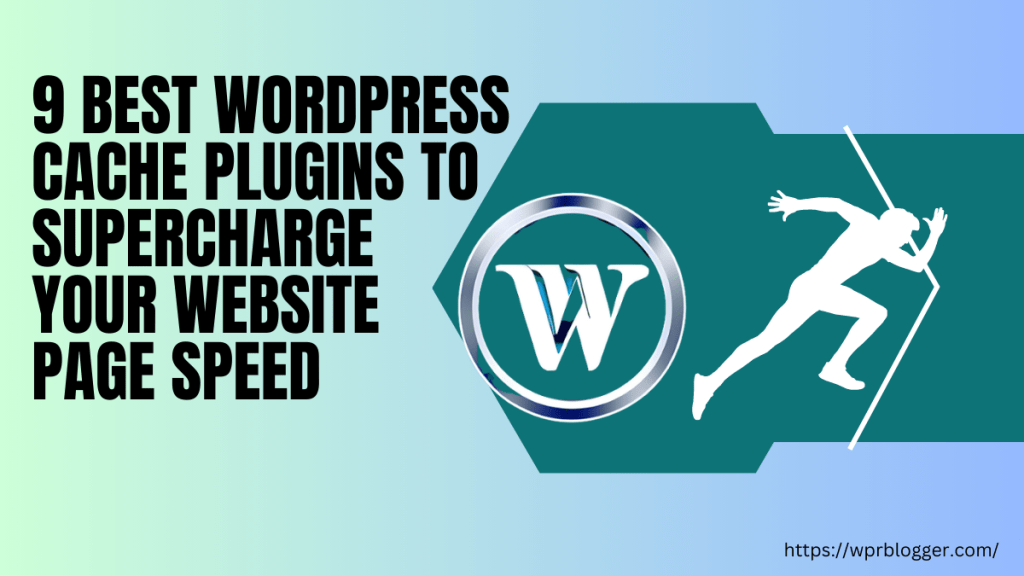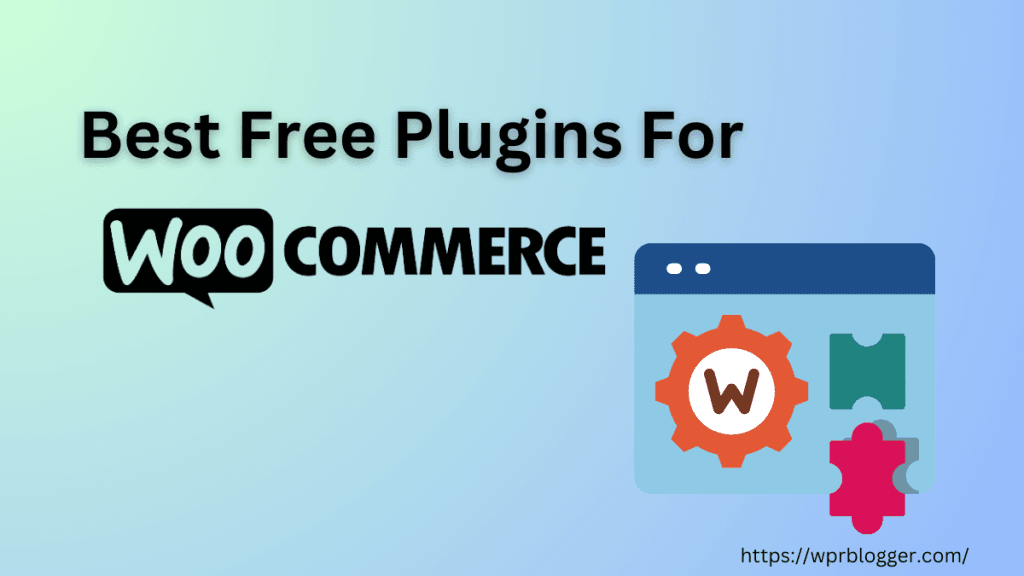One of the first decisions you’ll face as a WordPress beginner is whether to stick with free plugins or invest in paid ones.
Free plugins make it easy to start a blog or website without spending money, while premium plugins often unlock advanced features, better support, and regular updates.
The tricky part is knowing which option is right for you.
Should you go with free plugins to keep costs low, or pay for plugins that promise more control and reliability?
In this guide, I’ll break down the differences between free vs paid WordPress plugins, show you where each one makes sense, and help you decide what works best for your specific website.
What Are Free WordPress Plugins?
Free WordPress plugins are tools you can install on your site at no cost. You’ll find them in the official WordPress plugin directory, which is built right into your dashboard.
All you have to do is go to Plugins > Add New, type the name, author, tag, or keyword of the plugin you want, and click Install Now and Activate. In a few seconds, it’s ready to use.
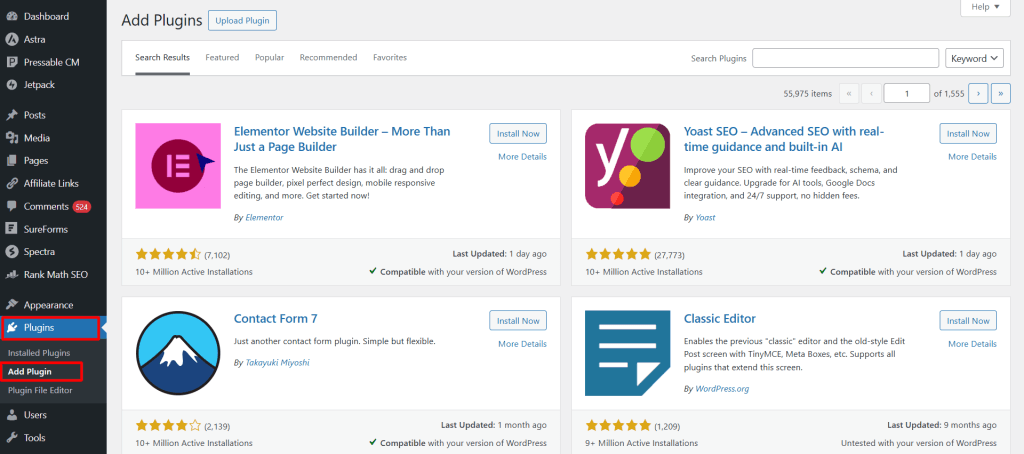
There are sixty thousand free plugins available at the time of writing, covering almost every need you can think of. If you need a contact form, you can use WPForms Lite, Ninja Forms, SureForms, or Contact Form 7.
If you want to improve your site’s search visibility, you can install the Rank Math Free SEO plugin. To speed up your site, there are free caching plugins, such as LiteSpeed Cache, Breeze, or W3 Total Cache.
These free versions often give you the core features you need to get started.
The main reason free plugins exist is that WordPress has an open-source community.
Developers create these tools to help users, build their reputation, or attract people to the premium version of the plugin. That’s why most free plugins have some limitations.
For example, WPForms Lite will let you build a simple contact form, but if you need advanced features, such as payment forms or integrations, you’ll need the paid version.
Free plugins usually come with community support, meaning you can post questions in the plugin’s support forum, but there’s no guarantee you’ll get a quick or detailed answer.
Updates also depend on how active the developer is. Popular free plugins with lots of installs usually get updated often, but smaller ones may not keep up with WordPress core updates, which can affect your website security and performance.
For instance, here’s a WordPress plugin that last received an update 1 year ago. For such a plugin, and to help protect its users, WordPress includes a notification that the plugin has not been tested with the latest WordPress core.
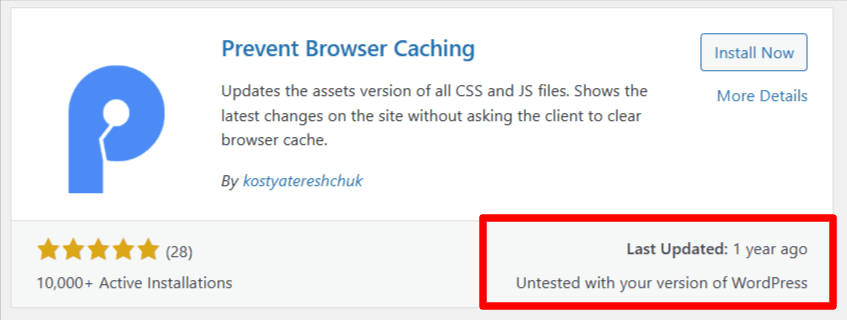
This means the plugin compatibility, performance, and even website security are uncertain. It may break your site, it may work, but you’re advised to install with caution.
In short, free plugins are an excellent starting point for beginners. They let you explore different features, test what works for your site, and save money in the early stages.
However, as your website grows and starts generating revenue, you might run into situations where the free version feels too limited. That’s when paid plugins come into play, which I’ll cover next.
What Are Paid (Premium) WordPress Plugins?
Paid, or premium, WordPress plugins are plugins you buy from developers or companies instead of downloading for free from the plugin directory. These plugins usually come as a ZIP file that you upload to your site manually, or sometimes you get a license key that allows you to unlock extra features inside the free version.
Premium plugins exist because developers need a way to support development efforts, ongoing updates, add advanced functionality, and provide customer support.
Unlike free plugins, where you’re on your own or dependent on community forums, paid plugins typically include direct support from the developer’s support team. This is a big advantage when you run into issues, especially if your website is important for your business.
For example, WPForms Pro expands on the free version by letting you create payment forms, registration forms, and integrate with thousands of services, including email marketing platforms.
Elementor Pro goes beyond the free drag-and-drop editor by adding advanced widgets, theme building, and custom design controls.
SEO plugins, such as Rank Math Pro or All-in-one SEO Pro, unlock features, such as advanced schema, content insights, and internal linking suggestions.
Most paid plugins also follow a subscription model, meaning you pay yearly or monthly for updates and support.
Some plugins, like Astra Pro or CartFlows, offer lifetime deals where you pay once and get updates forever, but that’s less common. The price range varies depending on the plugin; some cost as little as $30 per year, while others can be $600 or more for advanced site management or eCommerce features.
What you’re paying for with a premium plugin isn’t just the extra features. You’re also paying for reliability, security, and peace of mind.
Developers of paid plugins have a financial incentive to keep their products updated and secure, which makes them more dependable for long-term use.
If you’re running a hobby blog or experimenting, free plugins will often cover your needs.
But if your site is tied to your business, store, or brand, premium plugins can save you time, reduce technical headaches, and give you tools that free plugins simply don’t offer.
Pros and Cons of Free Plugins
Free plugins are a big reason why WordPress is so popular. They make it easy for anyone to build a functional website without incurring upfront costs.
But like anything free, there are trade-offs you should be aware of.
The biggest advantage is obvious – you don’t have to pay a dime.
This is great when you’re starting your first site or experimenting with different features. You can try several plugins for SEO, backups, or forms without worrying about your budget.
Free plugins are also useful for testing whether a feature is worth having before committing to a premium version.
For instance, you might install LiteSpeed Cache to see how caching affects your site speed before deciding if a paid performance plugin is necessary.
Another advantage is that many free plugins are lightweight and focus only on the essentials. This makes them easier to use for beginners and less overwhelming compared to premium plugins that pack in dozens of advanced features you might not need.
On top of that, free plugins are often supported by a large community of users who share tips, tutorials, and troubleshooting advice. If you run into a common WordPress problem, chances are someone has already posted a solution in the WordPress support forums.
On the downside, free plugins usually come with limitations.
You’ll often find that the basic features work fine, but anything more advanced is locked behind the paid version.
Using WPForms Lite as an example, you can build a simple contact form, but if you want to accept payments or create conditional logic, you’ll need WPForms Pro.
Support is another area where free plugins fall short. Since developers aren’t being paid directly for the free version, they may not have the time to respond quickly to every question.
You can post in the support forum, but responses may take days or never come at all.
Updates can also be inconsistent.
Well-known free plugins like WooCommerce get updated regularly, but smaller or less popular plugins may go months or years without an update, which could leave your site vulnerable or cause compatibility issues with newer WordPress versions.
So, while free plugins are fantastic for starting out, they come with strings attached. You save money, but you trade off some convenience, reliability, and access to advanced features.
Pros and Cons of Paid Plugins
Paid plugins are designed to give you more control, more features, and stronger support than their free versions.
For many site owners, that peace of mind is worth the cost. But before you jump in, it’s important to understand both the upsides and the trade-offs.
The biggest benefit of premium plugins is access to advanced functionality.
With a free SEO plugin, you can edit meta titles and descriptions, but the paid version might unlock advanced features like custom structured data, track keywords, write with AI, advanced content analysis, robot.txt editor, etc.
Free form plugins let you build a simple contact form, while a paid one like WPForms Pro lets you create payment forms, multi-step surveys, and integrate directly with third-party tools, including Zapier.
These features can save you from needing multiple separate plugins, which also reduces bloat on your site.
Another strong advantage is dedicated support. When you’re paying for a plugin, you’re not just buying the code; you’re also buying access to the developer’s help.
This can mean priority email support, live chat, or ticket systems where issues get solved quickly.
If your site depends on a plugin for eCommerce, security, or SEO, having fast support can make the difference between a minor hiccup and hours of downtime.
Regular updates are another reason premium plugins stand out.
Because developers earn revenue from subscriptions, they have a reason to keep improving the plugin, fixing bugs, and ensuring compatibility with the latest version of WordPress and PHP. This makes them more reliable for long-term use.
That said, there are a few downsides.
Cost is the most obvious one. Most premium plugins charge monthly or annually, and the price can add up if you need several for your site.
Some plugins also offer features you might never use, which can make the interface feel overwhelming for beginners. It’s easy to get tempted by the marketing around a plugin, pay for it, and later realize you only needed one or two of its features.
Finally, no plugin is perfect. Even premium ones can have bugs or conflicts with other tools. The difference is that you’ll usually get help faster when you’re paying, but you still need to be prepared for occasional troubleshooting.
So, while premium plugins often provide a smoother experience, they aren’t always necessary. The decision comes down to whether the added features and support justify the cost for your particular website.
When Should Beginners Use Free Plugins?
If you’re just starting out with WordPress, free plugins are usually the best place to begin. They give you the core features you need without putting pressure on your budget.
For a beginner, this is important because it lets you focus on learning how WordPress works instead of worrying about recurring costs right away.
One of the best times to use free plugins is when you’re building a personal blog, portfolio, or hobby website. In these cases, you likely don’t need advanced features.
Even with a free Rank Math version, you can optimize your posts, while LiteSpeed Cache (100% free) can speed up your pages, and a free backup plugin like UpdraftPlus Free can keep your site safe.
You get the essential features covered without spending anything.
Free plugins are also useful for testing features before making an investment.
Let’s say you’re not sure if you’ll really use a form builder. Installing WPForms Lite gives you a feel for the interface and how forms work in WordPress.
If you later discover you need payment forms or surveys, you can upgrade to Pro with confidence. This “try before you buy” approach keeps you from wasting money on tools you may not need.
Another situation where free plugins work well is when your site has very simple needs. A local business website, for example, may only need a contact form, a Google Maps embed, and some basic SEO.
Free plugins can handle all of that without issue. Even a small online store can get started with free WooCommerce add-ons for payments, shipping, and coupons.
In my experience, free plugins are a great choice when you’re just getting your site off the ground, when you want to experiment with new tools, or when your website doesn’t require advanced functionality. They give you enough to build confidence with WordPress while keeping costs at zero.
When Should Beginners Consider Paid Plugins?
There comes a point when free plugins just don’t cut it anymore, and that’s when paid plugins start to make sense.
As a beginner, you don’t need to rush into buying paid plugins, but if your site plays an important role in your work or business, premium plugins can save you a lot of time and frustration.
One clear sign it’s time to consider a paid plugin is when your website is tied to revenue.
If you’re running an online store with WooCommerce, for example, you may need features like recurring subscriptions, advanced checkout flows, or automated abandoned cart emails.
While WooCommerce itself is free, most of the tools that help you grow your sales, such as CartFlows Pro or premium payment gateways, are paid add-ons. In this case, the cost is an investment in your business.
Another situation is when your site requires advanced functionality that free plugins don’t provide.
A free contact form may be fine for a basic website, but if you need forms that accept payments, register users, or connect with other marketing tools, you’ll need something like WPForms Pro or Gravity Forms.
Similarly, while free SEO plugins cover the basics, a premium one like Rank Math Pro gives you schema markup, advanced keyword tracking, and internal linking suggestions, all tools that can directly impact your traffic.
Support is another big reason to go premium.
Free plugins rely on community forums, but that can be slow and unpredictable. If your site is down because of a plugin issue, waiting days for an answer isn’t an option.
With paid plugins, you usually get direct access to a support team that can walk you through fixes quickly. For anyone running a business or a client website, that level of reliability is worth paying for.
Security and long-term stability also matter.
Developers of paid plugins have a financial incentive to keep their tools updated and secure. This makes premium plugins less risky in the long run, especially if your site handles sensitive customer data or online payments.
So, if your website is just a personal project, free plugins are fine. But once your site starts generating income, attracting more traffic, or handling important tasks, premium plugins give you the tools and support you need to keep everything running smoothly.
Tips for Choosing Between Free and Paid Plugins
Deciding whether to stick with a free plugin or upgrade to a paid one doesn’t have to be complicated. The key is to match the plugin’s features or benefits to your website’s actual needs instead of guessing or buying into hype.
The first step is to think about your site’s purpose.
If you’re running a simple blog or portfolio, free plugins will usually be enough. On the other hand, if you’re building a business site or an eCommerce store, premium plugins may be worth the cost because they save you time and add the advanced features you’ll eventually need.
Next, check the reputation of the plugin. In the WordPress plugin directory, look at the star rating, the number of active installs, and how recently it was updated.
A plugin with hundreds of thousands of installs, significant user review counts, and regular updates is more likely to be reliable than one with only a few users and no recent activity. Not many plugins will reach millions of active installations; this is just to show you some popular plugins.
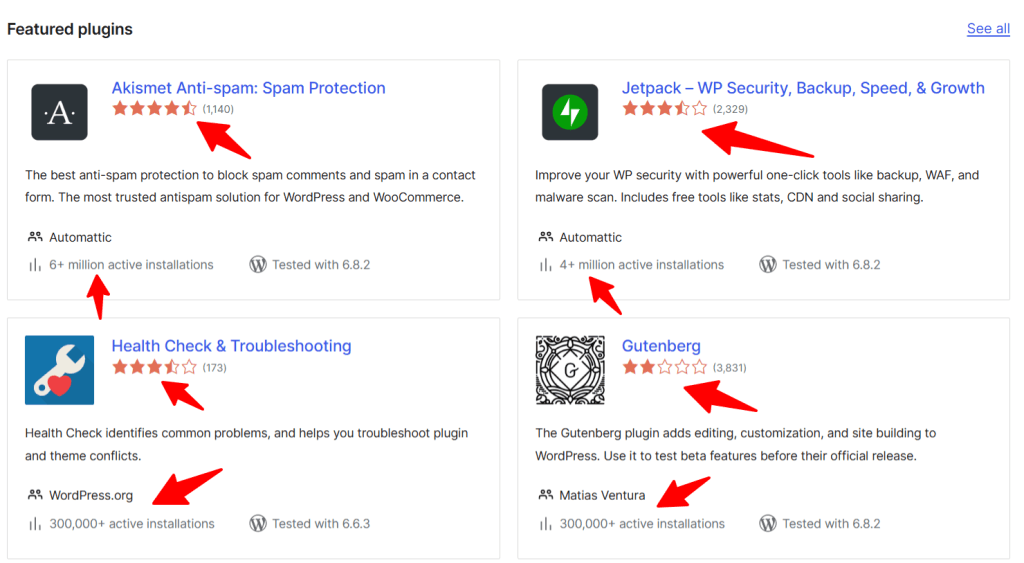
If you’re buying a premium plugin, make sure it comes from a trusted developer or company with a track record of maintaining their products. The download count may be
Another smart approach is to test the free version first, if one is available. Many popular plugins, like WPForms, WooCommerce, Elementor, and Rank Math, offer free versions with enough features to get you started.
Using the free version gives you a feel for the interface and features and helps you decide whether upgrading makes sense. This way, you only spend money when you’re sure the plugin fits your needs.
You should also weigh the cost against the value it brings. Some plugins may seem expensive at first, but if they save you hours of work or help you earn more through your website, they can easily pay for themselves.
For example, the WP Rocket caching plugin can directly affect your traffic and revenue. Because it helps improve site speed and user experience, which are critical factors to higher rankings. And a higher ranking can lead to more conversions, sales, and revenue.
Finally, avoid downloading nulled or pirated versions of premium plugins.
They might look tempting because they’re free, but they often contain malware or backdoors that can put your site at serious risk. It’s always safer to stick with the official source, whether it’s the WordPress directory or the developer’s website.
When you think about your site’s purpose, check reviews, test free versions, and make smart investments, you’ll have no problem figuring out when to stick with free plugins and when to go premium.
Common Mistakes Beginners Make with Plugins
Plugins make WordPress flexible, but as a beginner, you’ll often run into problems because of limited knowledge about best practices. Understanding the common mistakes can help you avoid headaches down the road.
One of the biggest mistakes is installing too many plugins. It’s tempting to add a plugin for every feature you come across, but this can slow down your site and sometimes cause conflicts.
For example, running multiple caching or SEO plugins at the same time often leads to conflict and can break your site. A good rule is to keep your plugin list lean and only install what you really need.
Another mistake is paying for features you don’t actually use. As a beginner, you may jump straight to the premium version of a plugin because of marketing claims, only to discover that you only needed one or two of the free features.
This can lead to wasted money and a more complicated dashboard. It’s always better to test the free version first, then upgrade only if the advanced features solve a real problem for your site.
A serious but common practice is using nulled or pirated plugins. These are “cracked” copies of premium plugins offered on shady websites.
While they might look like a free shortcut, they often contain malware, hidden links, or backdoors that hackers can use to compromise your site. Cleaning up after an infected plugin usually costs far more than the license fee would have.
Beginners also make the mistake of ignoring updates. Plugins need regular updates to stay compatible with the latest version of WordPress and to patch security issues.
Skipping updates can leave your site vulnerable or cause features to break. At the same time, updating without a backup can also be risky; if something goes wrong, you’ll want a way to restore your site.
Lastly, some beginners rely on plugins for everything, even when a simpler solution exists.
For example, installing a plugin to add a single line of code to your site is often unnecessary. The more plugins you install, the more maintenance your site will require, so it’s worth learning when to use a plugin and when a quick manual tweak is better.
Avoiding these mistakes will help keep your WordPress site fast, secure, and easier to manage.
FAQs About Free and Paid WordPress Plugins
Are paid WordPress plugins worth it?
Yes, paid WordPress plugins are worth it if you need advanced features, reliable updates, and dedicated support. Free plugins work for basic needs, but premium plugins usually save time, offer better security, and give you tools that help your site grow.
How many plugins should a beginner install?
There’s no fixed number, but it’s best to install only the plugins you really need. Most beginner WordPress sites run fine with 5–15 plugins, such as SEO, caching, forms, and backups. Quality matters more than quantity. Too many poorly coded plugins can slow down your site.
Can I use only free WordPress plugins forever?
Yes, you can run a website with only free plugins, especially for a blog or personal site. But if you run a business or online store, you’ll likely need at least one or two paid plugins for features like payment gateways, advanced SEO, or customer support.
Do plugins slow down WordPress?
Not always. Well-coded plugins don’t slow down your site much, even if you have many installed. The problem comes from poorly built or outdated plugins. Always choose plugins with good reviews, regular updates, and a history of active support.
Conclusion
Free and paid WordPress plugins both have their place, and the choice depends on your needs.
Free plugins give you a solid starting point without costing a dime, but they may not always scale with your site. Paid plugins often step in when you need advanced features, faster support, or peace of mind.
The best approach is to begin with free plugins, see how far they take you, and upgrade to premium when your site demands more.
By making smart choices and only adding the plugins that matter, you’ll keep your site secure, fast, and easy to manage.


